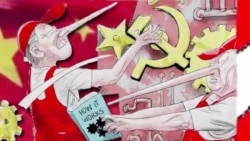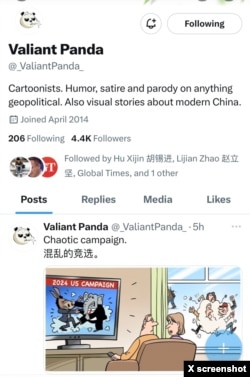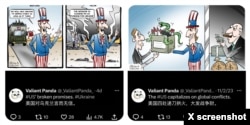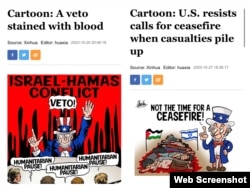During the Cold War era, governments used political cartoons for domestic and foreign propaganda. Nearly obsolete in today’s Western public diplomacy and legacy media, cartoons remain a powerful propaganda tool for many authoritarian regimes, including China.
That usage has been amplified by the emergence of generative artificial intelligence.
Political cartoons mocking Chinese authorities are prohibited on the Chinese internet. On Western social media platforms, however, Chinese state media has increasingly turned to this visual tool to transmit the Chinese Communist Party’s foreign propaganda and boost anti-U.S. disinformation.
Valiant Panda — an anonymous account on X (formally Twitter) is one such tool. Created in 2014, for a decade of its existence, the account had only posted some 850 tweets, most targeting the United States or its allies with vicious parody.
Polygraph.info identified five cartoonists behind the Valiant Panda account.
Chen Xia, Liu Rui and Tang Fengfei appear to be visual content journalists employed by the Global Times, the English language tabloid arm of the People’s Daily that provides news and commentaries on international affairs and China’s foreign relations from a nationalist perspective, and is a vital organ to the Chinese Communist Party’s foreign propaganda.
Carlos Latuff is a Brazilian political cartoonist known for illustrating themes such as anti-Western sentiment and anti-capitalism.
Vitaly Podvitski is a cartoonist from Russia, who creates illustrations for the Russian state media outlet Sputnik News. His bio says he portrays “the Russia perspective on world events.”
Despite its minuscule following base of only 4.4K followers, Valiant Panda’s content is regularly shared by Chinese state-affiliated media, government officials and agencies, including China’s foreign embassies. Valiant Panda also has its own page on Global Times English language edition website.
In the Valiant Panda cartoons, the United States is portrayed as the ultimate villain and China as the ultimate superhero. Everything the U.S. does domestically and globally is depicted as evil, while China is painted as the beacon of democracy and freedom.
Helping Ukraine defend itself from invading Russia — is propagated as hypocrisy and capitalization on global conflicts.
Gun violence — the epitome of the American Dream.
Condemning Uyghur rights abuses — double standards. And so on.
Valiant Panda’s sole purpose is attacking the U.S. and polishing China as none of its cartoons can be found on the Global Times main website in Mandarin, suggesting that government propagandists deem its content ineffective for domestic propaganda.
In a 2022 report examining China’s global influence operation, the Washington-based Freedom House found Beijing’s foreign propaganda target audiences include news consumers, Chinese expatriate or diaspora communities, and observers in China.
The phenomenon is not unique to the Global Times. The official state-run news outlet of the Chinese government, the Xinhua News Agency, has used political cartoons to mock America’s domestic issues and foreign policy in its English language edition.
Xinhua sits on top of China’s media hierarchy, setting the tone for other media outlets in the coverage of politically sensitive events.
Like Valiant Panda, the Xinhua cartoons do not stop at foreign policy parody, they often exploit societal concerns and tragedies, like mocking the issue of gun violence that grips American cities.
One such cartoon, titled “How a gun-happy nation spends its Fourth of July weekend,” was published on July 5 in both 2021 and 2023. It shows two men in business suits clinking glasses of wine and chanting “to freedom,” while a shooter next to them finishes their sentence with “of shooting.”
Similarly, Global Times had a cartoon mocking the U.S. on the anniversary of 9/11, when terrorists attacked the United States in 2001 by flying commercial airplanes into the World Trade Center buildings and the Pentagon.
Global Times’ official account shared a cartoon by Chen Xia and tagging Valiant Panda, with a caption that read: “U.S. continues to export turmoil 22 years after 9/11.” The cartoon features the Statue of Liberty staring down at a piece of paper, on which is written “22 years after 9/11.” The Statue of Liberty casts a shadow behind it, filled with bullets and Molotov cocktails. The post, published on September 10, received almost 29,000 views.
Video cartoons are another tool Chinese state media uses to push anti-U.S. propaganda and disinformation. For example, in a short video titled “Once Upon a Virus,” Xinhua mocked former U.S. President Donald Trump’s early remarks about COVID-19. The cartoon cited Trump’s description of COVID-19 as “only a flu,” and his advice to “not wear masks.” It then praised China for its handling the COVID-19 crisis with efficiency, while the Statue of Liberty, representing the U.S., is depicted as receiving an intravenous injection. The clip received 2.3 million views.
A study by the University of the Philippines Los Baños showcased how China has used political cartoons to repair its image and shift the blame on the U.S. during the pandemic.
The study, titled Visual Propaganda in The Time of COVID-19, examined 228 cartoons China’s state media published during the pandemic. It found that one of the major strategies employed was to “attack the accuser” in response to Trump’s accusations against China of creating and spreading the coronavirus.
Two themes — “the U.S. failed in its COVID-19 response,” and “the U.S. is peddling disinformation and conspiracies" – dominated Chinese government propaganda, accounting for nearly 70% of all cartoons in the dataset.
Other strategies by Chinese state media included “shifting the blame,” with 14.5% of the cartoons falsely implying that COVID-19 originated in the U.S. and another 14.0% of cartoons accusing the U.S. of hampering the global fight against COVID-19.














